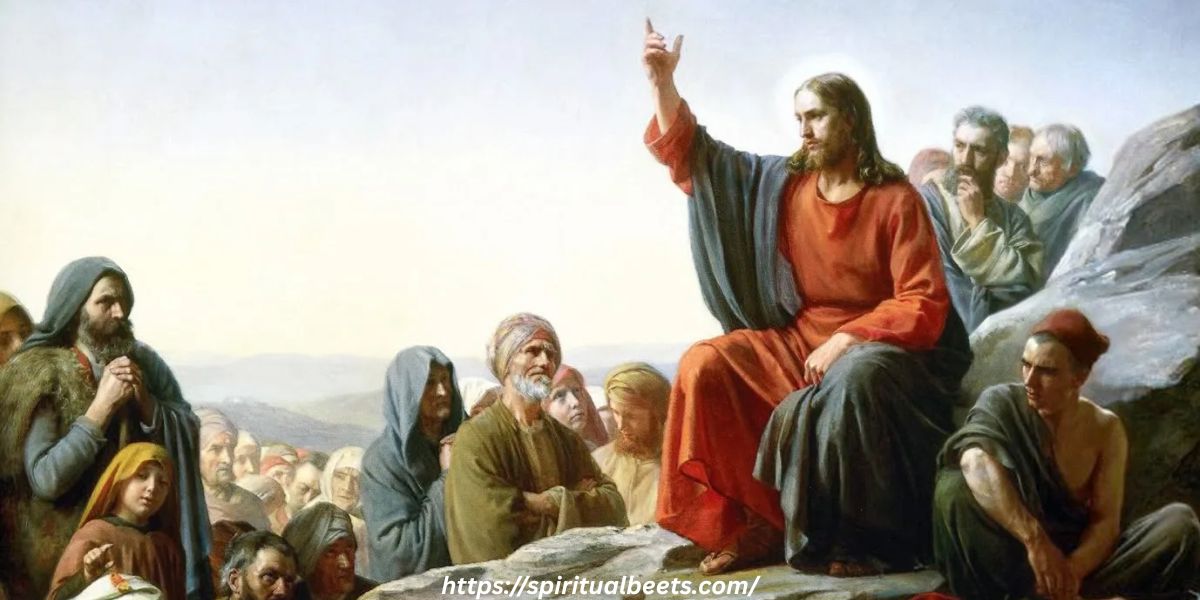Jesus of Nazareth is a powerful spiritual figure. His life inspires love, faith, and compassion. His teachings focus on forgiveness and kindness. His miracles and message bring hope, healing, and lasting impact worldwide.
Jesus: Undisputed Biblical Verses
Jesus is central to the Bible and Christian faith. Many verses clearly show His divine role and purpose. He is called the Son of God, the Savior, and the Light of the World. These verses reveal His love, truth and promise of eternal life.
Jesus’ Birth: Fulfillment of Prophecy
Jesus’ birth fulfilled ancient prophecies. The Old Testament spoke of a Messiah born in Bethlehem. His virgin birth was predicted in Isaiah 7:14. This prophecy was fulfilled when Mary gave birth to Jesus. The event marked a new chapter in God’s plan. Jesus’ birth shows God’s promise kept.
Read Also: Biblically Accurate God: Truth About His Divine Nature
Crucifixion and Resurrection: Cornerstones of Faith
The crucifixion of Jesus is one of the most important events in the Bible. He was nailed to a cross and died to take away the sins of the world. This was not the end.It was part of God’s plan. As Jesus said, “It is finished” (John 19:30), showing that His mission was complete.
Three days after His death, Jesus rose from the dead. This is called the resurrection. It proved He had power over death and gave hope to everyone who believes in Him. The angel at the tomb said, “He is not here; He has risen!” (Matthew 28:6).
The crucifixion and resurrection are the heart of Christian faith. They show God’s love, forgiveness, and promise of new life. As Romans 10:9 says, “If you believe in your heart that God raised Him from the dead, you will be saved.”
| Event | Meaning | Bible Verse |
| Crucifixion | Jesus died for our sins | John 19:30 |
| Resurrection | Jesus rose, defeating death | Matthew 28:6 |
| Faith in Action | Belief leads to salvation | Romans 10:9 |
Physical Descriptions of Jesus: Studies and Western Art
Jesus’ physical appearance is not clearly described in the Bible. Most Western art shows him with long hair, a beard and light skin. These images reflect European culture, not history. Scholars believe Jesus likely had darker skin, short hair and Middle Eastern features.
Symbolic Imagery in Revelation and Isaiah
The Book of Revelation is filled with powerful symbols. These symbols represent deeper spiritual truths. In Isaiah, many images point to the coming Messiah. Revelation uses vivid pictures of judgment and victory. Both books use symbolism to describe God’s plans. They show the battle between good and evil.
Western Art’s Role in Shaping Jesus’ Image
Western art has played a big role in shaping the image of Jesus. Artists in Europe began to depict him in ways that reflected their own culture. For centuries, Jesus was often shown as a white man with European features. This was influenced by the Renaissance and other art movements.
Many of these images, like those by Michelangelo and Leonardo da Vinci, became iconic. They shaped how people saw Jesus, even though the Bible does not describe his appearance. The Gospels focus on his teachings and miracles, not his looks. For example, in Isaiah 53:2, it says, “He had no beauty or majesty to attract us to him.”
The portrayal of Jesus in Western art has also affected religious practices. People in different cultures often imagine Jesus looking like themselves. This connection to art and culture shows how deeply these images have shaped the way we view him today.
Read Also: Biblically Accurate Archangel Michael
Comparisons Between Biblical and Western Depictions

The biblical and Western depictions of Jesus differ in many ways. The Bible does not give a detailed description of his appearance.While Western art often portrays him with European features. In contrast, the Bible focuses on his teachings and his role as the Savior, not his physical traits. This has led to differences in how people imagine Jesus based on cultural influences.
| Aspect | Biblical Depictions | Western Art Depictions |
| Physical Appearance | No detailed description (Isaiah 53:2) | Depicted as a white man with European features |
| Cultural Context | First-century Judea, Middle Eastern appearance | Reflects European cultural norms from the Renaissance era |
| Focus | Focus on teachings, miracles, and character | Focus on beauty, symbolism, and idealized features |
| Representation | Humble, servant-like image (Matthew 20:28) | Majestic, king-like, and powerful (Revelation 19:16) |
Scholarly Debates on the Historical Jesus’ Physical Form
Scholars debate the physical form of the historical Jesus. The Bible does not give a clear description. Some believe he had typical Jewish features, like dark skin and short hair. Others think Western art’s portrayal with fair skin and long hair is influenced by culture. These debates show how hard it is to know Jesus’ exact appearance.
Archaeological Insights into First-Century Jewish Life
Archaeological discoveries have shed light on life in first-century Judea. Excavations have uncovered homes, streets and tools from this time. These findings help us understand daily life during Jesus’ era. For example, in the Gospel of Mark, it says Jesus preached in synagogues and visited local homes (Mark 1:21-29). These sites show how people lived and worked.
One important discovery is the Pilate Stone. Found in 1961, it mentions Pontius Pilate, who oversaw Jesus’ crucifixion. This stone confirms the Roman governance described in the Bible (John 18:29). Other artifacts, like the Nazareth Inscription, show Roman concerns about tombs, linking to the story of Jesus’ resurrection (Matthew 28:13-15).
The ruins of Capernaum also provide insight. Jesus performed many miracles here (Mark 1:21-28). Archaeologists have found a first-century synagogue that matches the descriptions in the Gospels. These discoveries bring the Bible’s historical context to life, grounding spiritual teachings in real, tangible places.
Joan Taylor’s Research on Jesus’ Likely Appearance
Joan Taylor is a scholar who studied Jesus’ likely appearance. She used historical and cultural research to understand how Jesus might have looked. In her book What Did Jesus Look Like? Taylor suggests that Jesus probably had dark skin, common for people in first-century Judea.
Taylor also points out that Jesus most likely had short hair. This fits with Roman and Jewish customs of the time. In 1 Corinthians 11:14, Paul mentions that long hair on men was considered unnatural. This supports the idea that Jesus probably did not have long hair like many Western depictions.
Additionally, Taylor believes Jesus had typical Middle Eastern features. He would have had a beard, as was customary for Jewish men. This aligns with the descriptions in the Gospels, where Jesus is often portrayed with a beard. Taylor’s research shows that Jesus’ appearance was likely much different from the way Western art portrays him today.
Table: Comparing Historical Jesus vs Western Art Depictions
The historical Jesus likely had features typical of a first-century Jewish man. While Western art often portrays him in ways influenced by European culture. Over time, artists changed his appearance to match their own ideals, leading to a difference between the historical Jesus and the images seen in Western art. Below is a table comparing the two:
| Feature | Historical Jesus | Western Art Depictions |
| Skin Color | Dark, typical of Middle Eastern men | Light skin, often white |
| Hair | Short and dark | Often long, light-colored |
| Facial Hair | Likely had a beard | Varies, sometimes clean-shaven |
| Build | Average build for a first-century man | More muscular or idealized features |
| ClothingJewish | Simple, traditional robes | Fine, elaborate garments in many depictions |
Teachings of Jesus: Universally Accepted Verses

The teachings of Jesus focus on love and kindness. One of his most famous teachings is the Golden Rule: “Do unto others as you would have them do unto you” (Luke 6:31). He also taught to love everyone, saying, “Love your neighbor as yourself” (Matthew 22:39). Jesus encouraged forgiveness and compassion for all. His words continue to inspire people today.
The Beatitudes: Foundations of Christian Ethics
The Beatitudes are teachings from Jesus. They are found in Matthew 5:3–12. Each one starts with “Blessed are.” They teach love, mercy, and humility. These form the core of Christian ethics.
Parables: Lessons for Everyday Life
Parables are simple stories with deep meanings. Jesus often used them to teach important lessons. These stories were easy to understand and relevant to everyday life. For example, in the Parable of the Good Samaritan (Luke 10:25-37), Jesus teaches us to love our neighbors, no matter who they are.
Another well-known parable is the Parable of the Prodigal Son (Luke 15:11-32). This story shows us the importance of forgiveness and redemption. The father forgives his son, who returns after making mistakes. This teaches us that no matter how far we stray, God’s love is always there to bring us back.
Parables like the Parable of the Sower (Matthew 13:1-23) also teach us about how we respond to God’s word. The seed represents the message of God. Some people accept it. While others ignore or reject it. Jesus reminds us to listen carefully and allow His teachings to grow in our hearts.
Interpretational Differences in Biblical Verses About Jesus
Interpretational differences in biblical verses about Jesus often arise due to varying theological views. Some see Him as the divine Son of God. While others view Him as a great teacher or prophet. These differences shape how people understand His life and teachings.
The Bread of Life Discourse: Literal vs. Symbolic Interpretations
Jesus said, “I am the bread of life” (John 6:35). Some take this literally, like in the Catholic Eucharist. Others see it as symbolic, meaning spiritual nourishment. These views create big differences in belief. Each group sees deep meaning in Jesus’ words.
| Interpretation Style | Belief Explanation | Example Group |
| Literal | Jesus meant real body in communion | Roman Catholics |
| Symbolic | Jesus meant faith gives spiritual life | Protestants, Baptists |
Trinitarian Verses: Unity and Diversity Among Denominations
Trinitarian verses speak of God as Father, Son and Holy Spirit. Some Christians see them as one God in three persons. Others focus more on their separate roles. This causes different beliefs in churches. Verses like Matthew 28:19 and John 10:30 show both unity and diversity
Denominations and Sects Arising from Differing Interpretations
Different interpretations of the Bible have led to the creation of various Christian denominations. Catholics follow the Pope and church traditions. While Protestants emphasize the Bible and personal faith. The Eastern Orthodox Church follows its own traditions and leadership. These differences have resulted in the development of many distinct denominations and sects.
Jehovah’s Witnesses: Jesus as Michael the Archangel
Jehovah’s Witnesses believe that Jesus is Michael the Archangel. They teach that Michael is the highest created being and that he became human to fulfill God’s plan. According to their beliefs, Jesus’ earthly role was part of God’s salvation work. This view differs from traditional Christian teachings that see Jesus as the Son of God, not an angel.
| Belief | Jehovah’s Witnesses | Traditional Christianity |
| Identity of Jesus | Jesus is Michael the Archangel | Jesus is the Son of God |
| Nature of Jesus | Created being | Eternal, divine Son |
| Role on Earth | Part of God’s salvation plan | Savior, divine redeemer |
Mormonism: Jesus as Brother of Lucifer
Mormonism teaches that Jesus and Lucifer are brothers, both created by God the Father. According to this belief, they were two of many spirit children of God. Jesus chose to follow God’s plan, while Lucifer rebelled. This belief is unique to Mormonism and differs from mainstream Christian views.
| Belief Aspect | Mormonism View | Traditional Christianity View |
| Jesus and Lucifer’s relationship | Brothers, both created by God | Jesus is the Son of God, Lucifer is a fallen angel |
| Jesus’ role | Savior, chosen by God | Savior, eternal Son of God |
| Lucifer’s role | Rebelled, became Satan | Fallen angel, opposed to God |
| Source | Book of Mormon, LDS teachings | Bible, Christian tradition |
Common Ground and Points of Contention Among Abrahamic Religions
Abrahamic religions Judaism, Christianity and Islam share common roots in the worship of one God. They all honor key figures like Abraham and believe in sacred scriptures. However, they differ on beliefs about God’s nature, prophets and salvation.
Islamic Perspective: Jesus as Prophet
In Islam, Jesus (Isa) is considered a revered prophet, not the Son of God. Muslims believe he performed miracles and was born to the Virgin Mary. However, they do not accept his crucifixion, instead believing he was raised to heaven by God.
Jewish Perspective: Jesus as a Historical Figure
In Judaism, Jesus is seen primarily as a historical figure. He is not considered the Messiah or divine. While some Jews acknowledge his role in history, they reject the Christian belief in his resurrection and divinity.
Jesus: His Life, Miracles and Lasting Influence Compared
| Aspect | Description |
| Life | Born in Bethlehem, grew up in Nazareth. |
| Miracles | Healed the sick, raised the dead and turned water into wine. |
| Teachings | Preached love, forgiveness and the Kingdom of God. |
| Lasting Influence | Influenced Christianity and world history. |
| Cultural Impact | Shaped Western art, philosophy and values. |
Non-Abrahamic Religious Views on Jesus Exist

Many non-Abrahamic religions recognize Jesus. They see him as a wise teacher or holy man. These views differ from Christian beliefs.
Buddhist Interpretations of Jesus
Buddhists see Jesus as a wise and kind teacher. His message of love and peace is like Buddha’s. They respect him deeply. But they do not follow him as a savior.
Hindu Interpretations of Jesus
Many Hindus see Jesus as holy. Some believe he is an avatar, like Krishna. His life shows truth, love, and sacrifice. They honor him but follow many paths to God.
Jesus in the Context of the Ancient Planet
Jesus lived in the first century. He walked and taught in real towns. Roman records talk about him. This shows Jesus was a real person in history.
Historical Records and Archaeological Evidence Supporting Jesus Christ
Historical records mention Jesus as a real person. Writers like Tacitus and Josephus confirmed His life and death. Archaeological finds, like the Pilate Stone, support Bible accounts.
Tacitus and Josephus: External Confirmations
Tacitus was a Roman historian. He wrote about Jesus’ crucifixion under Pilate. Josephus, a Jewish historian, also mentioned Jesus. Both confirm Jesus lived in the first century.
Archaeological Discoveries Related to Jesus
Many findings match Bible stories. The Pilate Stone proves Pilate was real. The Capernaum synagogue matches Gospel events. These discoveries support Jesus’ life and setting.
Key Stats About Jesus
| Stat | Details |
| Birthplace | Bethlehem, Judea |
| Mother | Mary |
| Father | God (Holy Spirit) |
| Ministry Length | About 3 years |
| Crucifixion Date | Around AD 30-33 |
| Resurrection | 3 days after crucifixion |
| Primary Teachings | Love, forgiveness, salvation |
| Key Miracle | Healing, raising the dead, turning water into wine |
| Followers | Millions worldwide today |
My Personal Experience with Jesus: His Life, Teachings, Miracles and Impact
My personal experience with Jesus has been deeply meaningful. His teachings of love, forgiveness, and compassion have guided me through tough times. I often find comfort in verses like Matthew 11:28, where He invites us to find rest in Him.
Jesus’ miracles, like calming the storm in Mark 4:39, remind me that nothing is too difficult for Him. His life and teachings continue to inspire me to live with purpose, kindness, and faith. Through His example, I’ve learned to approach life with a heart full of grace and hope.
Frequently Asked Questions
What can we learn from Jesus’ teaching and miracles?
We can learn about love, compassion, faith and the power of forgiveness from Jesus’ teachings and miracles.
How has Jesus changed the world?
Jesus changed the world by teaching love, forgiveness and salvation, inspiring global change.
What are the 5 lessons from Jesus?
The five lessons from Jesus are love, forgiveness, faith, service, and humility.
Why did Jesus perform miracles?
Jesus performed miracles to show God’s power and help others.
What is the golden rule of Jesus?
The golden rule of Jesus is to “love your neighbor as yourself” (Matthew 22:39).
Conclusion
Jesus’ life, teachings, and miracles have left a profound impact on the world. His message of love, forgiveness and service continues to inspire people today. Through his teachings, we are reminded to treat others with kindness and compassion.
Ultimately, the influence of Jesus extends beyond religious boundaries. His example of selflessness and humility teaches us valuable lessons about living a purposeful life. His legacy encourages us to live with love, integrity and faith.
I have three years of professional experience writing articles about spiritual meaning, symbolism and metaphysical concepts. My expertise includes interpreting symbolic themes in religious texts, cultural traditions and personal experiences explaining abstract spiritual concepts through accessible analogies and real world examples and creating content that resonates with diverse audiences seeking deeper understanding of life’s purpose and universal truths. I specialize in crafting articles that balance intellectual rigor with emotional resonance, often incorporating elements of philosophy, psychology and cultural studies to help readers connect spiritual principles to practical life applications.




